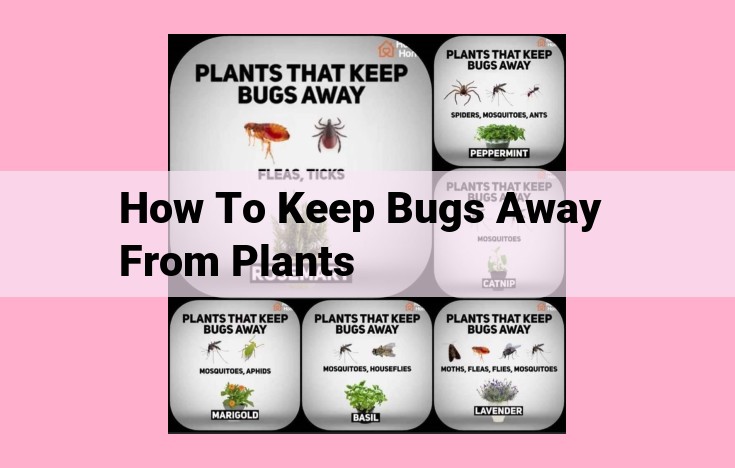Effective Bug Control: Natural And Physical Methods For Plant Protection

To keep bugs away from plants, employ beneficial insects like ladybugs that prey on pests. Utilize natural repellents such as garlic and marigolds, which release compounds that deter insects. Implement physical barriers like row covers and insect screens to prevent pests from accessing plants.
Beneficial Insects: Nature’s Pest Control Guardians
In the garden’s delicate ecosystem, beneficial insects play a crucial role as nature’s pest control heroes. These tiny allies, such as ladybugs,_ lacewings_, and hoverflies, are voracious predators that keep harmful pests in check.
Their Omnivorous Delicacies:
Beneficial insects have diverse feeding habits, targeting a wide range of pests. Ladybugs, for example, feast on aphids, mealybugs, and scale insects. Lacewings consume aphids, whiteflies, and spider mites, while hoverflies dine on aphids, fruit flies, and thrips.
Attracting and Supporting Insect Allies:
To attract beneficial insects to your garden, provide them with a welcoming habitat. Plant flowers that bloom throughout the season, offering a steady source of nectar and pollen. Avoid using pesticides, as they can harm these beneficial creatures. Instead, opt for organic gardening practices that create a healthy and thriving environment for insects.
Building Insect Hotels and Providing Water:
Insect hotels, made from natural materials like bamboo and wood, offer nesting sites for beneficial insects. A shallow dish of water with stones or marbles provides a safe watering spot for these thirsty allies. By providing these amenities, you’re fostering a thriving population of nature’s pest control team.
Beneficial insects are an essential part of a sustainable garden ecosystem. By understanding their role and supporting their presence, you can harness the power of nature’s pest control and create a healthy and pest-free gardening environment. Embrace these tiny allies and watch your garden thrive under their watchful eyes.
Natural Repellents: Repel Pests without Chemicals
In the realm of gardening, a battle rages against unwelcome visitors: pests. While chemical pesticides offer a quick fix, their harmful effects on our health and the environment cannot be overlooked. Natural repellents emerge as a safe and eco-friendly alternative, harnessing the power of plants to keep pests at bay.
Unveiling the Secrets of Plant Defenses
Plants possess remarkable defense mechanisms that release potent compounds to deter pests. Garlic, a versatile culinary herb, emits a pungent odor that repels insects. Onions, with their strong sulfurous scent, serve as a formidable barrier against aphids, thrips, and spider mites. The vibrant marigolds, in all their sunny glory, release alpha-terthienyl, a compound that acts as a natural insecticide.
Harnessing Plant Power for Pest Control
Incorporating these repellent plants into your garden is a simple yet effective way to repel pests. Interplanting garlic or onions among rows of vegetables creates a protective shield. Planting marigolds as a border around your garden forms a fragrant deterrent, keeping insects at bay.
Instructions for Using Natural Repellents
To maximize the efficacy of natural repellents:
- Choose healthy, vigorous plants from reputable nurseries.
- Plant them in well-drained soil that receives plenty of sunlight.
- Water regularly to maintain their vigor and pest-repelling capabilities.
- Avoid overfertilizing, as excess nitrogen can reduce the plants’ natural defenses.
- Supplement plant repellents with other pest management practices, such as crop rotation and companion planting.
Embrace the Natural Power of Pest Control
By utilizing the inherent pest-repelling properties of plants, gardeners can create a healthy and vibrant haven for their crops. Natural repellents offer a safe and sustainable solution, allowing us to nurture our gardens without compromising our health or the environment. Embrace the power of nature’s defense mechanisms and witness the wonders of pest control without chemicals.
Physical Barriers: Keep Pests Out Naturally
For nature-minded gardeners, keeping pests away from their beloved plants is a constant challenge. While beneficial insects and natural repellents offer eco-friendly solutions, sometimes a more direct approach is necessary. That’s where physical barriers come in.
Row Covers: A Protective Canopy
Row covers, made from lightweight fabric or netting, are a versatile tool for safeguarding plants from insects, birds, and even hail damage. By draping them gently over your crops, you create a physical barrier that prevents pests from reaching their leafy target. These covers are particularly useful for protecting young seedlings and delicate fruits from hungry critters.
Insect Screens: A Guardian at the Gate
Similar to row covers, insect screens act as a protective barrier, but they are designed for use in greenhouses or on windows and doors. Constructed from fine mesh, insect screens keep out even the smallest pests, allowing you to enjoy fresh air and sunshine without the annoyance of uninvited guests.
Sticky Traps: A Sticky Situation
For flying insects like aphids and whiteflies, sticky traps can be an effective way to trap and eliminate them. These traps consist of a sticky surface covered with a pheromone that attracts the target pest. Once lured in, the insects become stuck, unable to escape their sugary doom.
Choosing the Right Physical Barrier
When selecting a physical barrier, consider the target pest and the plants you’re protecting. Row covers are suitable for covering large areas, while insect screens are more appropriate for smaller spaces. Sticky traps are ideal for targeting specific insect populations.
Installing Physical Barriers
Installing physical barriers is relatively simple. For row covers, secure them to the ground with stakes or hoops. For insect screens, install them over windows or doors using magnets or adhesive strips. Sticky traps can be hung or placed near areas where pests are likely to gather.
Physical barriers offer a reliable and natural way to protect your plants from pests. By creating a physical impediment, you can effectively keep pests out while maintaining a healthy and vibrant garden. So, embrace these eco-friendly solutions and enjoy the peace of mind that comes with knowing your plants are shielded from unwanted visitors.